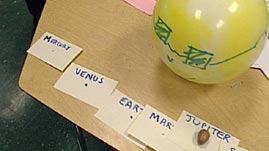Teachers' Domain - Digital Media for the Classroom and Professional Development
User: Preview

Source: WGBH Educational Foundation


A common question for the teaching of science is how to teach scientific inquiry. Setting up a fair experiment, prediction, and observation are components of scientific practices that need to be instilled in students from early years so that they can progress in the sciences in the higher grades.
So how does one relate a scientific skill, approach, or perspective? Real-world objects and visual representations can serve as teaching devices. If used well in the classroom, they may not only bring difficult topics into focus for students, but also teach scientific practices such as prediction-making.
In his Earth and space science class shown in this video, teacher Mark Goldner and his students work together on the scale of the solar system’s celestial bodies. They use familiar objects and the school environment to model the size and distance of things like Earth and the Sun. After charting out this data, they practice scientific practices of making predictions and inferences.
Classroom models can therefore play a role in the teaching of scientific inquiry by providing visual representations for the student’s imagination. They can help students scale large astronomical systems to a digestible size, and more generally afford students the chance to practice translating between visuals, abstract ideas, and data.
 Loading Standards
Loading Standards